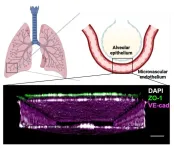(Press-News.org) Key takeaways
Whaling in the 20th century destroyed 99% of the Eastern North Pacific fin whale breeding population.
Because there is enough genetic diversity, current conservation measures should help the population rebound without becoming inbred.
The future of fin whales in the Gulf of California depends on the recovery of the Eastern North Pacific population.
A new genomic study by UCLA biologists shows that whaling in the 20th century destroyed 99% of the Eastern North Pacific fin whale breeding, or “effective,” population — 29% more than previously thought.
But there is also some good news: Genes among members of this endangered species are still diverse enough that current conservation measures should be be enough to help the population rebound without becoming inbred. The study also found that the health of this group is essential for the survival of highly isolated, genetically distinct fin whales in the Gulf of California.
The study, published in Nature Communications, is among the first to use whole genome information to get a picture of the size and genetic diversity of today’s population. Previous studies had to rely on whaling records or mitochondrial DNA, which is inherited only from the mother, providing limited genetic information.
In the 19th century, whaling decimated most whale species around the world but left the largest ones — blue and fin whales — largely untouched. That changed with the advent of industrial whaling in the 20th century. By midcentury, close to a million fin whales worldwide had been slaughtered, at least 75,000 of these in the Eastern North Pacific.
“When you look at whaling records, you can only tell how many were killed. You can’t tell how many there were to begin with,” said corresponding author Meixi Lin, who worked on the project as a UCLA doctoral student and is now a Carnegie Institution for Science postdoctoral fellow at Stanford University. “We know 20th century whaling was severe, but we didn’t know how severe it was for fin whales.”
To find out, then-postdoctoral researcher and corresponding author Sergio Nigenda-Morales extracted DNA from tissue samples taken from wild fin whales in the Eastern North Pacific and the Gulf of California. He rounded this out with DNA provided by colleagues at the National Oceanic and Atmospheric Administration. In all, 50 whales were studied. Fin whales from the Gulf of California were included because the population there had been undisturbed by whaling, enabling researchers to assess their genetic diversity and learn how they were related to the Eastern North Pacific population.
“Getting samples from live whales is hard, because you don’t know where they’re going to be —and when they come up, you only have a moment to take the sample before they go back underwater,” said Nigenda-Morales, now an assistant professor at Cal State San Marcos. “It is a humbling experience to conduct field research and interact with the second-largest animal on the planet.”
The genome analyses revealed that the Gulf of California population diverged around 16,000 years ago, with a population that hovered around 114 adults of reproductive age. The population of breeding adults is a key indicator of a species’ ability to sustain itself. The Eastern North Pacific effective population remained at around 24,000 individuals for thousands of years, until a severe decline happened between 26 and 52 years ago — a period that coincides with 20th century whaling — to only about 305 individuals.
Past ecological studies had suggested a 70% reduction in fin whale populations, while earlier genetic studies estimated a much larger pre-whaling population.
“It’s usually hard to detect such strong recent reductions in the genome. But in this case, fin whales were really abundant before, which made the sudden reduction very obvious in our data. If the reduction hadn’t been so strong, we wouldn’t have been able to detect it,” Nigenda-Morales said.
When a population suffers such a drastic decline, harmful genes left in the remaining organisms can become amplified over time as the small population size inevitably forces individuals carrying those genes to breed together. These harmful genes can reduce the health of the overall population and cause it to die out. Genetic diversity is still high among Eastern North Pacific whales, meaning that multiple versions of many genes are still plentiful and harmful genes have not yet become common.
“Most of this variation originated long, long ago, so genetic diversity in the small number of surviving individuals comes from their ancient history,” said co-author Kirk Lohmueller, a UCLA professor of ecology and evolutionary biology.
Luckily, thanks to the slow pace of fin whale reproduction, the population reduction caused by whaling at its strongest point lasted for only two fin whale generations — a 50-year span — and ended with the implementation of the international whaling moratorium in 1985. Since then, the population has slowly recovered, and harmful genes have not had time to pile up.
However, computer simulations show that if the population remains at its current size, the diversity will begin to vanish. The study’s authors write that the most important thing governments can do to aid fin whale recovery is to continue to enforce the whaling ban so that fin whales have time to increase their numbers.
The future of fin whales in the Gulf of California also depends on the recovery of the Eastern North Pacific population. The genomic analysis showed that many harmful genes have become common in the former group, and that the only source of new genetic variants is the occasional Eastern North Pacific whale who wanders into their territory about once in every three generations. This infusion of new genetic material, however, has been enough to keep the population going.
For now, current protections for both populations appear sufficient, though they will need to remain in place for a long time. But climate change, ship strikes and other human-caused disturbances could jeopardize the species’ recovery. The authors expect that ongoing research will help identify additional conservation measures.
“With improvement in computational models, we can incorporate factors like climate change and relate the risk of extinction from human-mediated processes with what’s happening at the genomic level,” said Lohmueller. “Continuing to develop such models is as important as collecting more data.”
Nigenda-Morales and Lin undertook the research as doctoral students of UCLA professor and senior author Robert Wayne, who continued working on the project until he passed away late last year. The authors have dedicated the paper to him.
END
Whaling wiped out far more fin whales than previously thought
UCLA study shows a 99% population reduction in the 20th century, but genetic diversity remains high
2023-10-17
ELSE PRESS RELEASES FROM THIS DATE:
Human Lung Chip leveraged to faithfully model radiation-induced lung injury
2023-10-17
By Benjamin Boettner
(Boston) — The lung is one of the tissues most sensitive to radiation in the human body. People exposed to high radiation doses following nuclear incidents develop radiation-induced lung injury (RILI), which affects the function of many cell types in the lung, causing acute and sustained inflammation, and in the longer term, the thickening and scarring of lung tissue known as fibrosis. RILI also is a common side effect of radiation therapy administered to cancer patients to kill malignant cells in their bodies, and can limit the maximum radiation dose doctors can use to control their ...
Texas A&M receives over $1 million in USDA grants to study SARS-CoV-2 in deer
2023-10-17
Texas A&M University scientists and research partners have received two National Institute of Food and Agriculture (NIFA) Agriculture and Food Research Initiative (AFRI) grants to study the spread of SARS-CoV-2 in deer. These funds will help researchers understand the impact of the virus in Texas’ deer populations and its relationship to human and ecological health.
For these projects, the research team will focus on captive deer, which are an agricultural species in Texas, including managed deer that live on large, rural properties enclosed by fences, as well as on the wild deer with which captive deer may interact and deer living ...
SwRI develops novel solution to advance synthesis for nerve agent antidotes
2023-10-17
SAN ANTONIO - October 17, 2023 — Southwest Research Institute has developed a unique technology (US20230242487A1) that enables the safe and efficient synthesis of organophosphorus nerve agent (OPNA) oxime antidotes. Using this technology, SwRI scientists can not only successfully synthesize currently known highly effective nerve agent countermeasures, but also effectively develop promising new drug candidates to treat nerve agent exposure.
Current treatments for OPNA exposure have not changed significantly since the 1950s. OPNAs are odorless and colorless chemicals ...
The Foundation for Angelman Syndrome Therapeutics to advance gene therapy candidate through IND-enabling studies conducted in partnership with the University of Pennsylvania
2023-10-17
October 17, 2023—The Foundation for Angelman Syndrome Therapeutics (FAST) announced today that the non-profit organization has entered into an exclusive global collaborative research and development agreement with the University of Pennsylvania to develop an investigational adeno-associated virus (AAV) gene therapy for Angelman syndrome (AS).
Angelman syndrome is a nondegenerative neurogenetic disorder that is estimated to impact approximately 1 in 15,000 births, or potentially 500,000 individuals world-wide, ...
Harnessing molecular power: electricity generation on the nanoscale
2023-10-17
WASHINGTON, Oct. 17, 2023 – Wave energy technology is a proven source of power generation, but there is power inherent in every molecule of liquid on earth, even when the liquid is at rest. At the molecular scale, atoms and ions are always moving. If this nanoscale movement can be harvested, it could be a big source of energy.
“There are vast amounts of air and liquid on the earth, and their successful harvesting could produce a gigantic amount of energy for society,” author Yucheng Luan said.
In an article published this week in APL Materials, by AIP Publishing, Luan and his collaborators tested a molecular energy harvesting device that captures ...
Study reveals our European ancestors ate seaweed and freshwater plants
2023-10-17
For many people seaweed holds a reputation as a superfood, heralded for its health benefits and sustainability, but it appears our European ancestors were ahead of the game and were consuming the nutrient-rich plant for thousands of years.
Researchers say they have found “definitive” archaeological evidence that seaweeds and other local freshwater plants were eaten in the mesolithic, through the Neolithic transition to farming and into the Early Middle Ages, suggesting that these resources, now rarely eaten in Europe, only ...
Effects of the million hearts model on heart attacks, strokes, and Medicare spending
2023-10-17
About The Study: The Million Hearts Model, which encouraged and paid health care organizations to assess and reduce cardiovascular disease (CVD) risk, reduced first-time heart attacks and strokes. The results support guidelines to use risk scores for CVD primary prevention.
Authors: Laura Blue, Ph.D., of Mathematica in Washington, D.C., is the corresponding author.
To access the embargoed study: Visit our For The Media website at this link https://media.jamanetwork.com/
(doi:10.1001/jama.2023.19597)
Editor’s Note: Please see the article for additional ...
Climate network analysis helps pinpoint regions at higher risk of extreme weather
2023-10-17
WASHINGTON, Oct. 17, 2023 – Climate change and the rapid increase in frequency of extreme weather events around the globe – such as wildfires and floods – reinforces the reality that these events are not only not random but, rather, interconnected. Interlinked climate behavior, or teleconnections, isn’t a well understood field but will be necessary to fully comprehend how our climate system works.
In Chaos, from AIP Publishing, a team of researchers affiliated with Beijing Normal University and Beijing University of Posts and Telecommunications in China and the Potsdam Institute for Climate Impact Research in Germany describes a climate network analysis method to explore ...
Race and ethnicity and prehospital use of opioid or ketamine analgesia in acute traumatic injury
2023-10-17
About The Study: The results of this study of over 4.7 million patient encounters across the U.S. during a 3-year period suggest that patients from racial and ethnic minority groups with acute traumatic injuries do not have their pain treated equitably in the prehospital setting.
Authors: Eli Carrillo, M.D., of the Stanford University School of Medicine in Stanford, California, is the corresponding author.
To access the embargoed study: Visit our For The Media website at this link https://media.jamanetwork.com/
(doi: 10.1001/jamanetworkopen.2023.38070)
Editor’s Note: Please see the article for additional ...
Adult attention-deficit/hyperactivity disorder and the risk of dementia
2023-10-17
About The Study: In this study of 109,000 individuals born between 1933 and 1952 and followed up in old age, adult attention-deficit/hyperactivity disorder (ADHD) was associated with an increased risk of dementia. Policy makers, caregivers, patients, and clinicians may wish to monitor reliably for ADHD in old age.
Authors: Stephen Z. Levine, Ph.D., of the University of Haifa in Haifa, Israel, is the corresponding author.
To access the embargoed study: Visit our For The Media website at this link https://media.jamanetwork.com/
(doi: 10.1001/jamanetworkopen.2023.38088)
Editor’s Note: Please see the article for additional information, including ...
LAST 30 PRESS RELEASES:
Autistic and non-autistic faces may “speak a different language” when expressing emotion
No clear evidence that cannabis-based medicines relieve chronic nerve pain
Pioneering second-order nonlinear vibrational nanoscopy for interfacial molecular systems beyond the diffraction limit
Bottleneck in hydrogen distribution jeopardises billions in clean energy
Lung cancer death rates among women in Europe are finally levelling off
Scientists trace microplastics in fertilizer from fields to the beach
The Lancet Obstetrics, Gynecology, & Women’s Health: Taking paracetamol during pregnancy does not increase risk of autism, ADHD or intellectual disabilities, confirms new gold-standard evidence review
Taking paracetamol during pregnancy does not increase risk of autism, ADHD or intellectual disabilities
Harm reduction vending machines in New York State expand access to overdose treatment and drug test strips, UB studies confirm
University of Phoenix releases white paper on Credit for Prior Learning as a catalyst for internal mobility and retention
Canada losing track of salmon health as climate and industrial threats mount
Molecular sieve-confined Pt-FeOx catalysts achieve highly efficient reversible hydrogen cycle of methylcyclohexane-toluene
Investment in farm productivity tools key to reducing greenhouse gas
New review highlights electrochemical pathways to recover uranium from wastewater and seawater
Hidden pollutants in shale gas development raise environmental concerns, new review finds
Discarded cigarette butts transformed into high performance energy storage materials
Researchers highlight role of alternative RNA splicing in schizophrenia
NTU Singapore scientists find new way to disarm antibiotic-resistant bacteria and restore healing in chronic wounds
Research suggests nationwide racial bias in media reporting on gun violence
Revealing the cell’s nanocourier at work
Health impacts of nursing home staffing
Public views about opioid overdose and people with opioid use disorder
Age-related changes in sperm DNA may play a role in autism risk
Ambitious model fails to explain near-death experiences, experts say
Multifaceted effects of inward foreign direct investment on new venture creation
Exploring mutations that spontaneously switch on a key brain cell receptor
Two-step genome editing enables the creation of full-length humanized mouse models
Pusan National University researchers develop light-activated tissue adhesive patch for rapid, watertight neurosurgical sealing
Study finds so-called super agers tend to have at least two key genetic advantages
Brain stimulation device cleared for ADHD in the US is overall safe but ineffective
[Press-News.org] Whaling wiped out far more fin whales than previously thoughtUCLA study shows a 99% population reduction in the 20th century, but genetic diversity remains high




